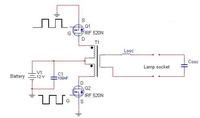jancambodia
Newbie level 6
center tapped transformer
Hi
I have the following circuit of a CFL ballast.

For the design I want to calculate the transformer, but I'm not sure how to do it because of the center tapped configuration. There is a 12V source connected to the center of the primary.
(1)
When I measure the voltage at the drain (mosfet that is turned off), I measure a voltage of 24 Volts. I would like to know how this is possible.
(2)
I want to know the input voltage of the transformer, is this a 24+24= 48 Vpp voltage? Is it possible to calculate this transformer in the same way as a transformer with 1 primary coil?
Thanks
Hi
I have the following circuit of a CFL ballast.

For the design I want to calculate the transformer, but I'm not sure how to do it because of the center tapped configuration. There is a 12V source connected to the center of the primary.
(1)
When I measure the voltage at the drain (mosfet that is turned off), I measure a voltage of 24 Volts. I would like to know how this is possible.
(2)
I want to know the input voltage of the transformer, is this a 24+24= 48 Vpp voltage? Is it possible to calculate this transformer in the same way as a transformer with 1 primary coil?
Thanks